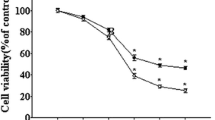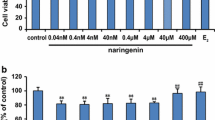Abstract
Previous evidences indicate that androgen is neuroprotective in the brain. However, the underling mechanisms remain to be fully elucidated. Moreover, it is controversial whether dihydrotestosterone (DHT) modulates the expression of apoptosis-related effectors, such as survivin, XIAP, bax, and bcl-xl proteins mediated by the PI3-K/Akt pathway, which contributes to androgen neuroprotection. In this study using a C6 glial cell model, apoptotic cells were detected by flow cytometry. Akt, seladin-1, survivin, XIAP, bcl-xl, and bax protein expression is investigated by Western blot. After amyloid β-protein fragment (Aβ25–35) treatment, apoptotic cells at early (annexin V+, PI−) and late (annexin V+, PI+) stages were significantly increased. Apoptosis at early and late was obviously inhibited in the presence of DHT. The effect of DHT was markedly blocked by PI3-K inhibitor LY294002.To elicit the mechanism of DHT protection, the expression of seladin-1, survivin, XIAP, bax, and bcl-xl protein was determined in C6 cells treated with Aβ25–35, DHT, or LY294002. Aβ25–35 significantly downregulated the expression of seladin-1, survivin, XIAP, bcl-xl protein and upregulated the expression of bax protein. DHT significantly inhibited the expression of bax, seladin-1, survivin, XIAP, and bcl-xl protein induced by Aβ25–35. Further, we found the effect of DHT was significantly inhibited by LY294002. Collectively, in a C6 glial cell model, we firstly found that DHT inhibits Aβ25–35-induced apoptosis by a rapid nongenic PI-3K/Akt activation as well as regulation of seladin-1, survivin, XIAP, bcl-xl, and bax proteins.





Similar content being viewed by others
References
Rosario ER, Chang L, Stanczyk FZ, Pike CJ (2004) Age-related testosterone depletion and the development of Alzheimer disease. JAMA 292(12):1431–1432
Carroll JC, Rosario ER (2012) The potential use of hormone-based therapeutics for the treatment of Alzheimer’s disease. Curr Alzheimer Res 9(1):18–34
Seyedreza P, Alireza MN, Seyedebrahim H (2012) Role of testosterone in memory impairment of Alzheimer disease induced by Streptozotocin in male rats. Daru 20(1):98
Pike CJ, Carroll JC, Rosario ER, Barron AM (2009) Protective actions of sex steroid hormones in Alzheimer’s disease. Front Neuroendocrinol 30(2):239–258
Pike CJ, Nguyen T-Vi V, Ramsden M, Yao M, Murphy MP, Rosario ER (2008) Androgen cell signaling pathways involved in neuroprotective actions. Horm Behav 53(5):693–705
Kalaria RN (1999) Microglia and Alzheimer’s disease. Curr Opin Hematol 6(1):15–24
Bachoo RM, Kim RS, Ligon KL, Maher EA, Brennan C, Billings N, Chan S, Li C, Rowitch DH, Wong WH, DePinho RA (2004) Molecular diversity of astrocytes with implications for neurological disorders. Proc Natl Acad Sci USA 101(22):8384–8389
Gatson JW, Singh M (2007) Activation of a membrane-associated androgen receptor promotes cell death in primary cortical astrocytes. Endocrinology 148(5):2458–2464
Foradori CD, Weiser MJ, Handa RJ (2008) Non-genomic actions of androgens. Front Neuroendocrinol 29(2):169–181
Yamagishi S, Yamada M, Koshimizu H, Takai S, Hatanaka H, Takeda K, Ichijo H, Shimoke K, Ikeuchi T (2003) Apoptosis-signal regulating kinase-1 is involved in the low potassium-induced activation of p38 mitogen-activated protein kinase and c-Jun in cultured cerebellar granule neurons. J Biochem 133(6):719–724
Gatson JW, Kaur P, Singh M (2006) Dihydrotestosterone differentially modulates the mitogen-activated protein kinase and the phosphoinositide 3-kinase/Akt pathways through the nuclear and novel membrane androgen receptor in C6 cells. Endocrinology 147(4):2028–2034
Xia Y, Cheng Z, Wang JL, Noelle C, Anastasio K, Johnson M (2010) Brain-derived neurotrophic factor prevents phencyclidine-induced apoptosis in developing brain by parallel activation of both the ERK and PI-3K/Akt pathways. Neuropharmacology 58(2):330
Nguyen N, Lee SB, Lee YS, Lee KH, Ahn JY (2009) Neuroprotection by NGF and BDNF against neurotoxin-exerted apoptotic death in neural stem cells are mediated through Trk receptors, activating PI3-kinase and MAPK pathways. Neurochem Res 34(5):942–951
Kudo W, Lee HP, Smith MA, Zhu X, Matsuyama S, Lee HG (2012) Inhibition of Bax protects neuronal cells from oligomeric Aβ neurotoxicity. Cell Death Dis 3(5):e309
Semaan SJ, Murray EK, Poling MC, Dhamija S, Forger NG, Kauffman AS (2010) BAX-dependent and BAX-independent regulation of Kiss1 neuron development in mice. Endocrinology 151(12):5807–5817
Shang YC, Chong ZZ, Wang S, Maiese K (2012) Prevention of β-amyloid degeneration of microglia by erythropoietin depends on Wnt1, the PI 3-K/mTOR pathway, Bad, and Bcl-xL. Aging (Albany NY) 4(3):187–201
Pfister B, Oyler G, Betenbaugh M, Bao G (2004) The effects of BclXL and Bax over-expression on stretch-injury induced neural cell death. Mech Chem Biosyst 1(4):233–243
Van DMF, Huang DC (2006) How the Bcl-2 family of proteins interact to regulate apoptosis. Cell Res 16(2):203–213
Scorrano L, Korsmeyer SJ (2003) Mechanisms of cytochrome c release by proapoptotic BCL-2 family members. Biochem Biophys Res Commun 304(3):437–444
Degli EM, Dive C (2003) Mitochondrial membrane permeabilisation by Bax/Bak. Biochem Biophys Res Commun 304(3):455–461
Kang MH, Reynolds CP (2009) Bcl-2 inhibitors: targeting mitochondrial apoptotic pathways in cancer therapy. Clin Cancer Res 15(4):1126–1132
Chong ZZ, Li F, Maiese K (2005) Stress in the brain: novel cellular mechanisms of injury linked to Alzheimer’s disease. Brain Res Rev 49(1):1–21
Greeve I, Hermans-Borgmeyer I, Brellinger C, Kasper D, Gomez-Isla T, Behl C, Levkau B, Nitsch RM (2000) The human DIMINUTO/DWARF1 homolog seladin-1 confers resistance to Alzheimer’s disease-associated neurodegeneration and oxidative stress. J Neurosci 20:7345–7352
Alessandro P, Mario S (2008) Neuroprotective effects of the Alzheimer’s disease-related gene seladin-1. J Mol Endocrinol 41:251–261
Peri A, Serio M (2008) Estrogen receptor-mediated neuroprotection: the role of the Alzheimer’s disease-related gene seladin-1. Neuropsychiat Dis Treat 4(4):817–824
Zu H, Wu J, Zhang J, Yu M, Hong Z (2012) Testosterone up-regulates seladin-1 expression by iAR and PI3-K/Akt signaling pathway in C6 cells. Neurosci Lett 514(1):122–126
Altieri DC (2010) Survivin and IAP proteins in cell-death mechanisms. Biochem J 430(2):199–205
Maier JK, Lahoua Z, Gendron NH, Fetni R, Johnston A, Davoodi J, Rasper D, Roy S, Slack RS, Nicholson DW, MacKenzie AE (2002) The neuronal apoptosis inhibitory protein is a direct inhibitor of caspases 3 and 7. J Neurosci 22(6):2035–2043
Robertson GS, Crocker SJ, Nicholson DW, Schulz JB (2000) Neuroprotection by the inhibition of apoptosis. Brain Pathol 10(2):283–292
Batrinos ML (2012) Testosterone and aggressive behavior in man. Int J Endocrinol Metab 10(3):563–568
Filová B, Ostatníková D, Celec P, Hodosy J (2013) The effect of testosterone on the formation of brain structures. Cells Tissues Organs 197(3):169–177
Białek M, Zaremba P, Borowicz KK, Czuczwar SJ (2004) Neuroprotective role of testosterone in the nervous system. Pol J Pharmacol 56(5):509–518
Gold SM, Voskuhl RR (2006) Testosterone replacement therapy for the treatment of neurological and neuropsychiatric disorders. Curr Opin Investig Drugs 7(7):625–630
Spence RD, Voskuhl RR (2012) Neuroprotective effects of estrogens and androgens in CNS inflammation and neurodegeneration. Front Neuroendocrinol 33(1):105–115
Gold SM, Voskuhl RR (2009) Estrogen and testosterone therapies in multiple sclerosis. Prog Brain Res 175:239–251
Dienel GA (2012) Exploring and mapping the world of astrocytes. Neurochem Res 37(11):2295–2298
Rossi D, Volterra A (2009) Astrocytic dysfunction: insights on the role in neurodegeneration. Brain Res Bull 80(4–5):224–232
Acknowledgments
This study was supported by research Grants (No. 10411961900) from the Science and Technology Commission of Shanghai Municipality, Shanghai, China.
Conflict of interest
The authors declare that they have no conflict of interest.
Author information
Authors and Affiliations
Corresponding author
Rights and permissions
About this article
Cite this article
Bing, L., Wu, J., Zhang, J. et al. DHT Inhibits the Aβ25–35-Induced Apoptosis by Regulation of Seladin-1, Survivin, XIAP, bax, and bcl-xl Expression Through a Rapid PI3-K/Akt Signaling in C6 Glial Cell Lines. Neurochem Res 40, 41–48 (2015). https://doi.org/10.1007/s11064-014-1463-3
Received:
Revised:
Accepted:
Published:
Issue Date:
DOI: https://doi.org/10.1007/s11064-014-1463-3




